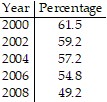Use Gauss-Jordan elimination to solve the linear system and determine whether the system has a unique solution, no solution, or infinitely many solutions. If the system has infinitely many solutions, describe the solution as an ordered triple involving variable z.x + 8y + 8z=87x + 7y + z=18x + 15y + 9z=-9
A. (-1, 0, 1)
B. (0, 0, 1)
C. (1, -1, 1)
D. no solution
Answer: D
You might also like to view...
Solve the equation for the indicated variable.F =  -
-  , m > n for a (force between two molecules)
, m > n for a (force between two molecules)
A. a = Frm + brm - n B. a = Frm + n + brm C. a = Frm - brm - n D. a = Frm - brn - m
Subtract.(0.9x4 - 0.4x3 + 0.2) - (2.3x4 + 2.7x - 2.9)
A. -1.4x4 - 0.4x3 - 2.7x - 2.7 B. -1.4x4 - 0.2x3 - 2.7 C. -1.4x4 - 0.4x3 + 2.7x + 3.1 D. -1.4x4 - 0.4x3 - 2.7x + 3.1
Find the sum. 1774.6 16.61 120.041
Fill in the blank(s) with the appropriate word(s).
Solve the problem.The table shows the percentage of seniors at a certain 4-year college who believed that after graduating they would be able to find a job related to their field of study. (a) Does the table define a function?(b) What are the domain and range?(c) Call this function f. Give two ordered pairs that belong to f.
(a) Does the table define a function?(b) What are the domain and range?(c) Call this function f. Give two ordered pairs that belong to f.
What will be an ideal response?